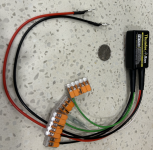RC-31
Well-known member
Only tap into a circuit that you're prepared to lose when your installation leads to a popped fuse.
Headlight is near the bottom of my list.
Headlight is near the bottom of my list.
Auto relays engage at about 9v and release at 1.2v. So it’s not likely to let go, but it’s not going to engage if it’s tricked into less than 9v.The frequency isn't the issue. PWM can reduce the effective voltage (that's the whole point). The relay won't work with a 3V signal (even if it has 5,000 spikes a second to 12V, they are all too short to pull the relay in).
Auto relays engage at about 9v and release at 1.2v. So it’s not likely to let go, but it’s not going to engage if it’s tricked into less than 9v.The frequency isn't the issue. PWM can reduce the effective voltage (that's the whole point). The relay won't work with a 3V signal (even if it has 5,000 spikes a second to 12V, they are all too short to pull the relay in).

Only tap into a circuit that you're prepared to lose when your installation leads to a popped fuse.
Headlight is near the bottom of my list.
Indeed. I have an inverter in my top box to provide 120v for various things while riding. Notably, my CPAP battery, and recharging the batteries for our heated vests, but anything else as well that doesn't have a 12v charging option. It's quite handy honestly.
This past summer while we were motocamping down in WV a few days in I found the USB ports also in my top box were dead - I use those through the day to recharge USB battery banks (light string, charging various stuff in the tent at night) and my tent fan if the weather is hot. Motocamping and long distance riding stuff.
Turned out the inverter had sh!t the bed, was causing a dead short as soon as it was turned on (instantly popping the fuse) and I'd wired both the inverter and my rear USB charging plugs on the same circuit which in retrospect turned out to be a bad choice.
Anyhow, we had power at our campsite so it wasn't a huge deal in the end, but had it happened on our James Bay Road trip this past summer it would have been a particularly huge issue in short order.
The inverter and the USB charger ports are now wired independently. So yeah, I agree, be thoughtful and careful about your accessory wiring.
I have one of these things too on my bike. I have very little space under my seat and this is super tiny and clean.Received my Thunderbox this week. I bought the big one, just because I got tired of thinking about the likelihood of adding devices X, Y and Z.
This thing is TINY.
View attachment 70626
I know I could have done the equivalent for less, but this was a case of me picking something that was eezy-peezy. Whatever I would have done would have looked like a dog's breakfast.
I'm curious what CPAP battery and heated vest batteries your using that require 120v?
For my CPAP I use a laptop battery bank and was able to find a cable online that charges it from 12v. It's a cable that has SAE and the right bullet connector. I have a Fired Up X heated vest that both batteries died. I took them apart and the power was 12v. I couldn't find any power banks that were that high, so again, I found a cable online that has an SAE connector for the bike, and a bullet connector I plug directly into the vest.
On my Grom, I wired in a powered relay (cheap amazon thing) to a distribution block (Princess Auto).
I have a small 24v pack from Amazon that is airline friendly which was a requirement for me as we travel a lot. Most CPAP’s are 24v now so a 12v pack was no good, and most tend to be large. Yes a 12v pack is an option with a step up transformer, but my experience with step ups is that they’re low efficiency so you need a bigger 12v battery to make up the amp hours, and they can be unreliable. The pack I have is native 24v so it feeds directly to the CPAP without any transformer needed, but the downside is that it needs 24v to charge as well, which in my case is a wall-wart charger plugged into the inverter.
As for the vest batteries, be careful feeding 12v straight into them for charging. I have the same vests and I’m 75% sure the voltage cut off circuitry is in the wall-wart chargers they come with - you’ll notice the LED on the charger indicates when it’s full. Plugging straight to 12v may be overcharging the batteries, and lithium batteries don’t like being overcharged of course.
Three out of four of our firedup vest batteries are still working fine at 4-5 years of age, so indeed perhaps it was the fact that you were overcharging them by not using the stock charger that caused them to fail.
Send me a link to the CPAP battery you use if you don’t mind, out of curiosity.
This is the one I use. At $80 (and $15 or something for the adapter cables to plug into my AirMini travel CPAP) it was a fraction of the cost of some other options I found.


